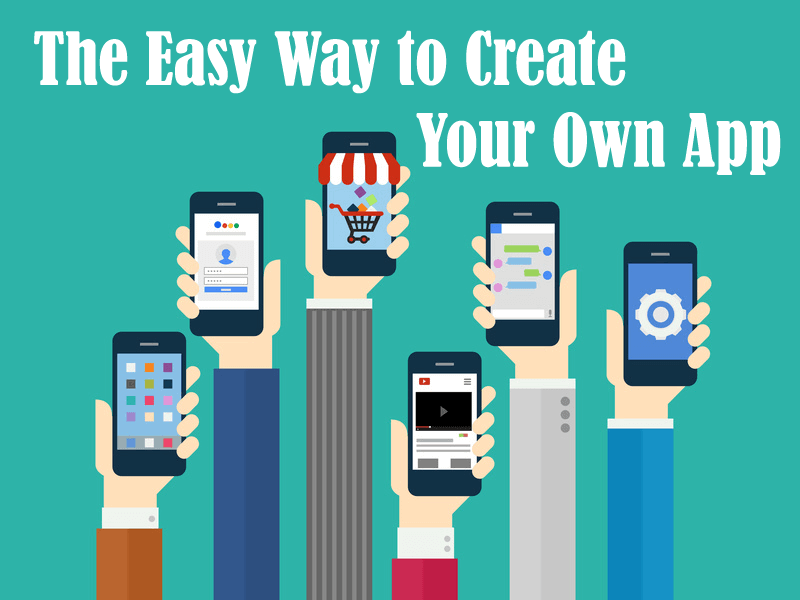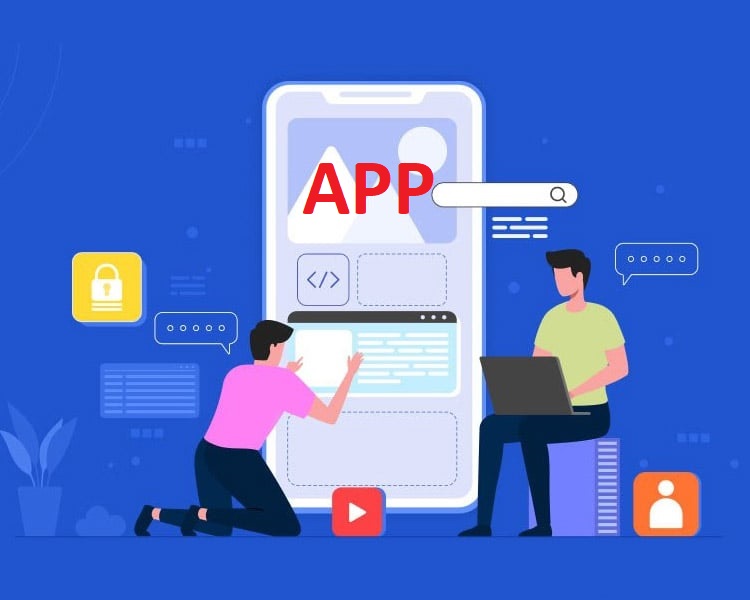The world has become mobile, this is no secret. Nowadays, whether it is day or night, we always have access to our devices. What are people using the devices for? Apps for mobile devices have countless possible uses.

Would you like to create an app? You’ve arrived at the proper location.
There is an app for anything you can think of, from small company applications to e-commerce apps, fitness apps, internal employee communication apps, and more. You can use apps to expand your current business or start a brand-new one from scratch.
This guide is for anyone who wants to design a mobile app, regardless of whether you want to build the next unicorn or an app for your company.
This tool will lead you through the process of developing an app in a way that is simple to grasp for novice developers, non-technical users, and anyone who has previously attempted unsuccessfully.
This comprehensive book is best read from beginning to end, but feel free to jump to the sections that interest you. Some of you are beginning, while others are further along.
Step-by-Step Guide on How to Create an App
Step 1:
Goals determine your development process. Once you begin app development, it’s simple to get lost if things aren’t explicitly defined.
Set attainable goals.
Use this as your north star to keep heading towards them. You won’t be efficient otherwise. It’s tempting to add features, bells, and whistles that aren’t essential to your aim since app development is almost endless.
Set end-user and business goals.
To fulfill your app development goals, you must distinguish between goals and objectives. Goals are your desired outcome. Goals are achieved through objectives such as:
Defining goals like “make more money” is a typical mistake, but that goes without saying. You’re not unique. A great goal should focus on your purpose and mission.
Success requires pre-defined measurements. Numeric KPIs work best.
If you wish to establish an app for your e-commerce store, one goal can be to reduce mobile shopping cart abandonment. You need to know your present abandonment rates to compare them to the figures when your app releases to make sure you’re meeting that target.
Step 2:
After setting goals, make sure your app is needed. Validate your app idea before proceeding.
Without market research, creating an app could squander time, money, and resources.
- Create surveys
- Interview
- Focus group
- Study your rivals
- Develop a customer-friendly app.
If your app is an extension of your business, use current customers for this study. If the app is for a novel idea, you’ll need to connect with target users.
Step 3:
Consider your app’s main features. Focus features there.
Many people want to add unneeded functionality to apps. Some functionalities distract from your app’s main purpose. Each feature add-on costs and delays development.
- Push alerts
- Community wall
- GPS.
- Surveys, questionnaires
- Video, picture, and audio hubs
- Reservations
- Calendar integrations
- E-commerce carts
- Menu ordering
- Customer loyalty
- User directory
Early development requires simplicity. You don’t need GPS if your app’s main function doesn’t require user location.
Step 4:
Wireframes are rough mobile app layouts. You don’t need to worry about graphic design or formality yet. Wireframes can be drawn on paper, whiteboards, napkins, or digitally.
Wireframes just show the app’s functionality and layout.
In a wireframe, ignore the app design. This tool doesn’t represent the final app. Structure and flow should dominate your wireframe.
User travel map. Show the results of clicking a button. What’s next? What occurs onscreen when a user clicks Option A or Option B?
Wireframes help your team understand your app vision.
Step 5:
Select Your Development Method
App development has many approaches. Before creating an app, choose the best approach for your situation.
There are several possibilities, from no-code app builders to software development outsourcing.
Budget, technical skill, app kind, and time to market determine the best option.
Mobile app development has five main methods. To help you choose the best way for your app, I’ll discuss each below.
BuildFire App Creation
This app creation program allows non-technical individuals to create apps using a large marketplace with many customization options.
BuildFire gives native apps more freedom than most RAD app builders. Using the BuildFire SDK, your developers can create unique functionality that hasn’t been established for the marketplace.
BuildFire offers white-glove services. BuildFire’s in-house developers can build unique features for you.
BuildFire requires no coding or technical experience. Thus, no new programming language is required.
Launch an iPhone and Android app concurrently utilizing a web-based platform. Choose a template and add features.
It’s the easiest method to build iOS apps for the App Store and Play Store. BuildFire lets anyone create an app in minutes.
BuildFire is a low-cost, customized app builder.
Native Development App Creation
Native development requires low-level coding. You’ll need to employ a developer if you don’t know how to code.
To launch native apps on the iOS App Store and Google Play Store, you’ll need a developer for each platform.
Programming languages are platform-specific. One developer can construct an app for both, but it will take twice as long and cost twice as much.
A full-stack web developer will build your cloud data backend architecture, together with iOS and Android app developers.
Native app development offers the greatest freedom. Coding from scratch lets your program do anything. Gaming and augmented reality app developers should use it.
Native apps are expensive and take the longest to produce.
How to Develop a Hybrid App
Hybrid development is cheaper than native. Web-based Javascript powers most hybrid builds.
This language lets you build an app once and deploy it on various platforms. An iOS and Android app can be coded once in Javascript.
Hybrid apps can still do a lot. It requires web development, but not low-level code.
Hybrid development saves time and money. Your app’s performance and quality may degrade.
Rapid App Development (RAD) App Builder: How to Make an App
Non-technical people that want to build their apps choose rapid app development. It’s cheaper than native and hybrid development and faster to launch.
RAD lets you construct an internet app using a tool.
These systems target non-technical users. Even with a simple app idea, this process requires technical knowledge.
To have your app accomplish anything beyond the basics, you will need some technological skills.
Rapid app development restricts builders to their app-building tool. You’ll only have that platform’s capability. Just configure those tools for your app.
RAD is suitable for simple apps like internal process mobile apps. Accept your limitations.
Cookie Cutter App Builder: How to Make an App
Cookie-cutter software makers are just that. You’re customizing one app.
You may easily turn on and off features and add personalized text, photos, color schemes, and other app design elements that match your branding.
This development method requires no coding. Cookie-cutter app builders have simple user interfaces. This isn’t technical.
This method of app creation is straightforward yet limited. Scaling will severely limit your functionality.
Cookie-cutter apps work for hobbyists and DIYers on a budget. They’re not business-friendly.
Step 6:
Research Existing Solutions
Pre-development concludes with solution research. Before spending time and money building an app and other components from scratch, check if a solution already exists.
App development services provide basic app functionality. Infrastructure, hosting, design, analytics, and push notifications.
Why host an app when you can rent servers from a solution?
Pre-built items are always cheaper than homemade ones. These services usually allow minor customization.
App creation is hard enough. Avoid complicating this process. Build what you need. Use existing tools for everything else.
This will save time, and money, and speed up app release. It also simplifies your life.
After pre-development, you can start app development. You’ve vetted your app concepts, done all the research, and know how the app should work by now.
Step 7:
Technical Specification
Create a “tech spec” from your pre-development wireframes.
Your app’s hidden inner workings. It can save time and money to change logistics.
App developers must evaluate both visual and technological issues in your wireframe.
Your tech spec may suggest other methods. Figure out these alternatives immediately to avoid months of work and thousands of dollars.
Get the facts, then decide.
User experience is always more essential than cost reduction and efficiency. Tech specs are still essential to development.
Instead of thinking, “I wish we did things differently” three or six months later, do it now. We could have saved so much time.”
Step 8:
Set Measurable Milestones
Setting milestones will help your app development team stay on schedule. You can’t track progress without benchmarks.
Divide your big development project into smaller parts. It’s easier to tackle several modest projects than one large one.
This underpins the agile framework, a prominent mobile app development method.
Small software projects must be finished on time. This could take days or weeks, depending on the task’s intricacy.
To meet deadlines, use this milestone timeline.
Use a software developer-friendly project management solution. Scrum and agile are great solutions.
Regardless of your choice, track your progress.
This will help you plan when to launch your app.
Step 9:
Create an MVP
Build an MVP—minimum viable product—as you build the software. MVPs force you to prioritize your app’s features. Creating a successful app requires this.
How does your app work? First, build those functionalities.
App development is nearly unlimited. The building can distract you from your aims. It’s easy to say “Let’s add this feature” a month or two into the project.”
They’ll delay and cost your project. They can even hinder your app’s essential functionality.
Add features later. The tutorial will handle this later in the app-making process.
MVPs are your app’s foundation. Make an app with just the essentials. It offers enough essential functionality for basic functions and use cases. Don’t worry about fancy design or distracting features. Not now.
Consider designing a texting app.
A messaging app is your MVP. You wouldn’t construct a video chat feature or alter the app’s typeface, images, or background color.
Recall the house analogy. House MVPs are four outside walls and a roof. No tent or kitchen. A tent can’t become a house, but a kitchen can.
MVPs aren’t entire apps, but they’re more than just tests.
Step 10:
Quality Assurance
Before deploying, test your MVP and functional app.
Mobile platforms must test the app. Quality assurance must test your software in all possible methods.
iPhones, iPads, Android devices, PWA, smartphones, tablets, and more are your challenge. Test the app online, offline, etc. Different program versions or screen sizes may cause unique challenges.
Don’t assume the app works after one test on your phone.
First-time app builders may question QA. Is paying for app testing necessary? Shouldn’t app developers be able to code without bugs?
In paradise, apps are perfect and never need testing. Developers write bugs and are famously lousy at finding them.
Avoid undermining QA. A quality assurance specialist can uncover app issues before release. Identifying these now avoids consumers from discovering them in real life.
Customer bugs will hurt your app’s long-term success.
Usability testing with real users can complement QA testing. Share the app with friends, family, and coworkers.
Launching the software without perfection is fine. However, eliminating all flaws and problems is preferable. Configure user experience and interface later.
Step 11:
Deploy
Start using your app.
Focus on uptime and visibility now. Ensure end-user functionality. Server crashes are bad.
Submit your app to app stores to market it. Android and iOS apps have different needs. Before starting, you must understand all submission rules.
In the pre-development section of this tutorial, we examined how your development method affects app deployment.
Best app builders help deploy. BuildFire will publish your app. Let us know when it’s done, and we’ll handle iOS and Android. So you may focus on development while our team does the tough lifting.
If you engage a development team or learn to create an app, the deployment procedure will be more complicated.
Post-launch Advice
Congratulations on learning app development! After deployment, mobile app development continues. Launching is only the beginning.
Avoid overspending on development and plan for post-launch steps.
App Promotion
Consider your app a business. Would you start a business without promotion? No way.
The world’s best app won’t matter if no one knows about it. Your app needs proper marketing to attract users.
Start with a website and app traffic. Visitor app installations. Installed apps pay.
Make sure you’re on all marketing platforms. Prioritize your users’ favorite channels. Promote your app on Facebook, Instagram, Twitter, and LinkedIn. Snapchat and TikTok can advertise the app to younger users.
Promote apps and make videos. YouTube them. Reuse the videos on different platforms.
Your mobile app marketing approach should target new users. Use inbound and outbound marketing to reach more people.
Marketing your mobile app will never end, and your techniques may evolve.
ASO—app store optimization—must be prioritized alongside traditional marketing. This boosts app store visibility.
Early marketing strategies can make or break your app. Start app marketing before launch. Before the software is released, promoting it builds excitement.
Create a “coming soon” app landing page.
Track KPIs
Is your app successful? KPIs—key performance indicators—are the only method to answer this issue.
Your app analytics and KPIs should go beyond app performance measures like speed and uptime (although these are essential for performance and reliability).
KPIs should reflect users’ app adoption.
App downloads? How many? Uninstalling or keeping the app? App usage: how often?
You need a mechanism to track new users, recurring users, app usage, and where users spend the most time. Your app’s success can’t be measured without these analytics. Business success requires data, not guessing.
KPIs in your App Store Connect account can show you which app components are performing well and which require work.
Let’s say most people use a feature you didn’t think was important. That data lets you make that feature more accessible on all screens. Move it up on your side menu or homepage.

User Feedback
Get user feedback.
You undoubtedly researched or polled friends before your initial launch. This was mostly intuition.
After the first deployment, clients will use the app. Ask their opinion. As much as you detest it, your customers and users count more than your viewpoint.
Ask for feedback—customers like it. Asking won’t bother non-participants. You’re ignored. They won’t mind.
Participating users will care about your app’s success and provide honest comments.
You must distinguish between fear of change and cost rise feedback. However, you can ask clients questions that encourage honesty.
User feedback will help you prioritize the next features.
You may have planned to perform something significant as soon as you could. Unless your customers say so, save your money. Buy what they want to keep them in your software. This will stop churning.
Enhance Your Mobile App
Apps are imperfect. Even the most popular programs update frequently. In the last stage, we explored using user feedback to deploy new software versions.
When making app updates, utilize the same method as during development. Before releasing, test the app.
Regression testing is also important when updating an app.
New feature deployments may cause new issues. Thus, the upgrade did not break something that functioned with your previous release.
Even minor app updates require re-QA. Only this can confirm that regression hasn’t produced a new app failure.
App updates are crucial. User feedback expects changes.
People may stop using your app if it’s not improved.
Support and Upkeep
App maintenance is constant. You must keep your development staff.
Mobile operating systems upgrade alongside your app. Your program must work with the newest Apple and Android OS.
Regulations and compliance can change. For instance, your app must comply with GDPR in Europe and CCPA in California. Credit card processing requires PCI compliance. HIPAA-compliant apps must handle medical data. Lists continue.
These conditions demand constant maintenance.
As your app grows, plan for customer assistance. How do app users get help? You can handle this alone at first. You can’t handle hundreds or thousands of potential messages at scale.
You may also require salespeople. All of this is post-launch assistance.
These are constants in mobile app development. Just plan and budget.
How to Make Money with an App
Apps can make money in several ways.
Mobile apps can boost corporate revenue. Mobile commerce, client loyalty, and referral schemes are great moneymakers.
Charge app customers a one-time fee to download your app. profiting from app purchases like coins or content upgrades is widespread. For recurring revenue, charge app customers a monthly or annual subscription.
Sell advertising space to monetize your app. Like website adverts.
Apps that save money may not make money. Internal business apps demonstrate this. Remote workers, field service workers, human resources, and internal communication apps can save your organization tens of thousands of dollars in productivity expenditures.
